The untold story of the Zoot Suit riots: How Black L.A. defended Mexican Americans
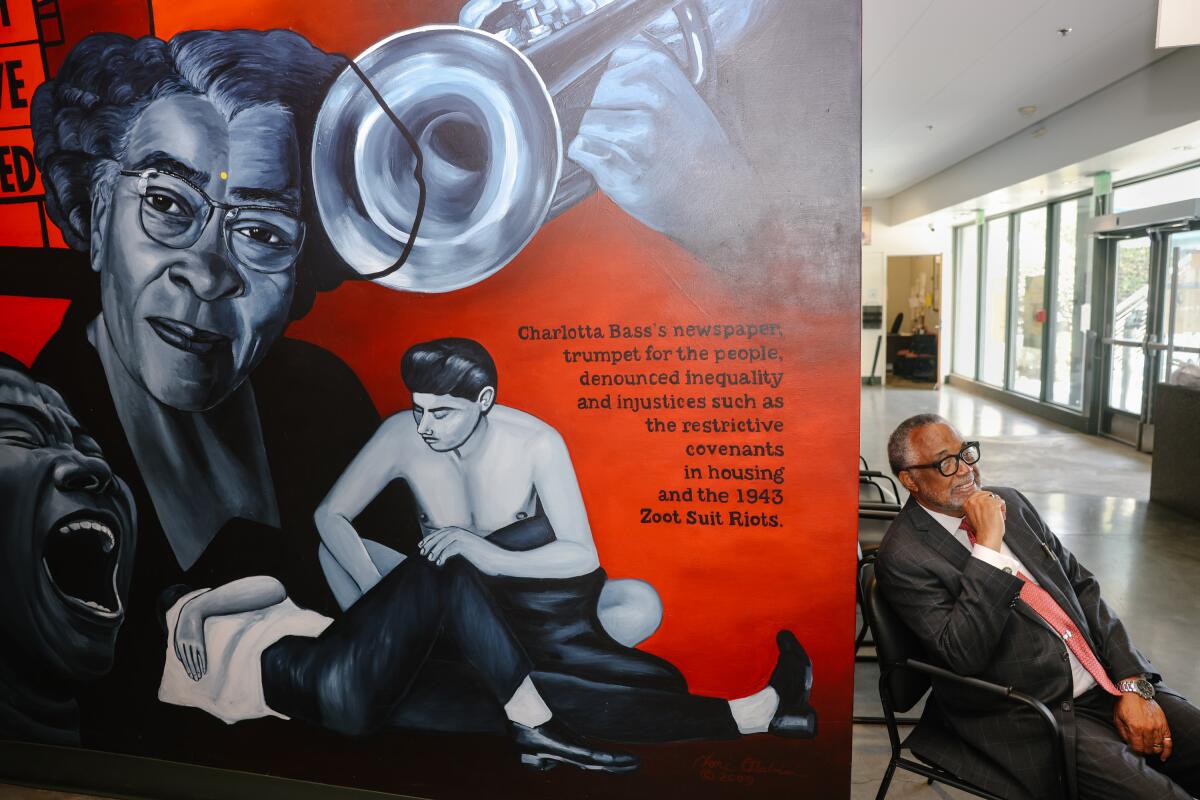
Farmers yelled their pitches for fruits and vegetables in English and Spanish. A hot-sauce seller offered samples. The synth-heavy melodies of duranguense swirled from someone’s speaker.
The Central Avenue Farmers’ Market in South Los Angeles was popping.
“The mix of Black and Latino cultures here is beautiful, so we need to nourish their dreams,” said Alejandro Corona, who runs the market for Sustainable Economic Enterprises of Los Angeles, a nonprofit.
Every Thursday, vendors set up in the courtyard and nearby sidewalk of the Central Avenue Constituent Services Center. Corona showed me a collection of murals inside the courtyard with Black and Latino motifs: monarch butterflies, ankhs, Aztec gods, and an ibis in red, black and green, the colors of the Pan-African flag.
But off to the side was another mural with a starker message.
It honored the Black-owned California Eagle and its publisher, Charlotta Bass. Her weekly newspaper, a caption noted, was a “trumpet for the people [that] denounced inequality and injustices.” Next to those words is an illustration of two young Mexican American men on the ground, victims of the Zoot Suit riots.
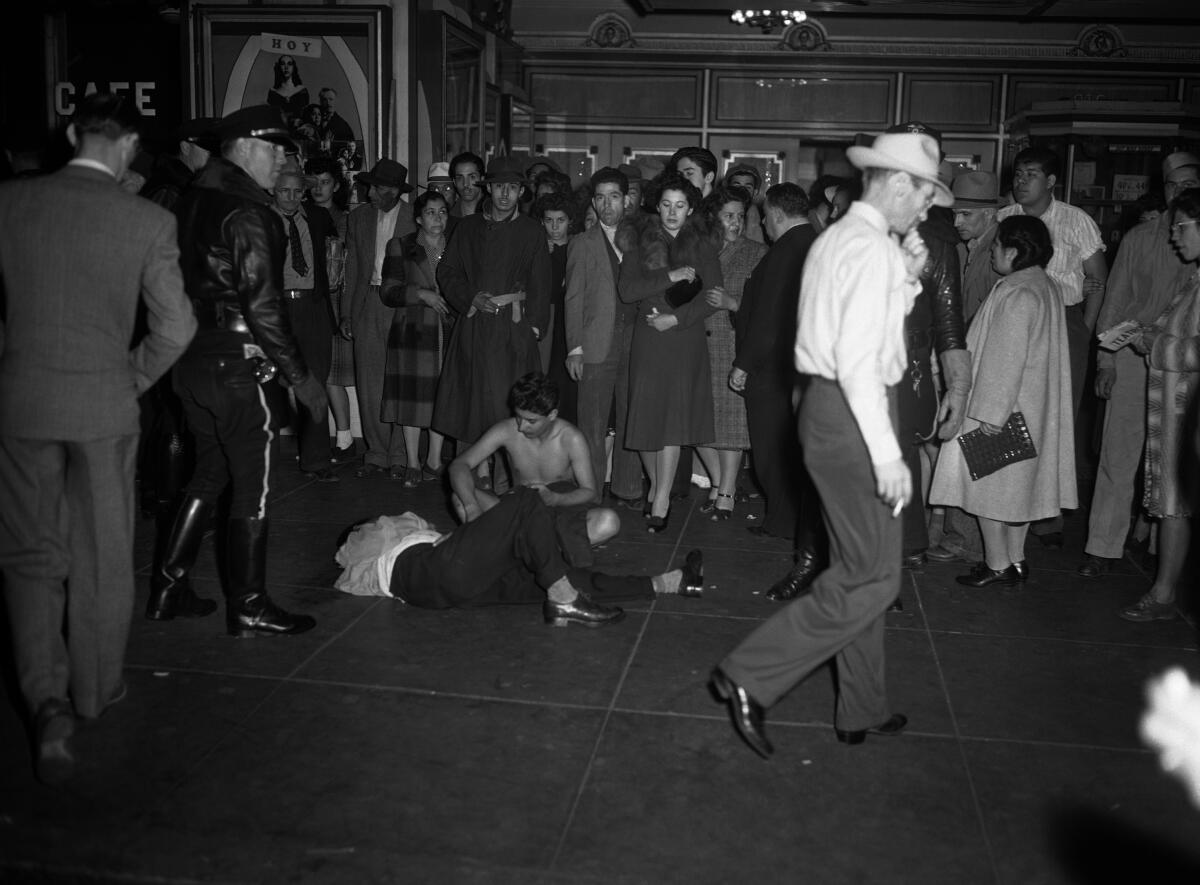
As L.A. observes the 80th anniversary of the unrest, which largely unfolded from June 3 to June 8,1943, much will be said about wartime xenophobia and bigotry. How thousands of white servicemen and civilians assaulted anyone who wore the flamboyant zoot suits — Black, white, Filipino, but especially Mexican American.
Less known is the story told in the Bass mural.
On June 10, 1943, the Eagle’s front-page headline screamed “Zoot Riot Jolts Watts.” Next to it a photo showed a young Black man with a bloodied lip. Dispatches from across the city painted the ugliness of a week of mayhem.
In an open letter to Mayor Fletcher Bowron, Bass decried the riots as “a white heat of lynch fury” and blamed the city’s dailies — including this paper — for kindling hatred over the previous year. “Nothing in my experience,” she wrote, “has been so vicious, deliberate, or disruptive as the campaign of our city’s metropolitan papers against” Mexican Americans.
The Eagle’s anger extended to its ads — the reason why I came to the Central Avenue Farmers’ Market.
The back page of the Eagle’s June 10 edition featured a full-page spread for the People’s Victory Market, a grocery co-op started by the Rev. Clayton D. Russell, one of the most prominent preachers in Black L.A. at the time.
Russell’s ad urged Black Angelenos to stand with Mexicans, who it said had been “shamefully attacked” by the press and police for far too long.
“Because we in the Negro community are more unified and have greater political power,” it read, “we must lead in the demand for FULL POLICE PROTECTION OF THE MEXICAN COMMUNITY IN LOS ANGELES. ... We must say to our great United Nations neighbor, Mexico — SALUDOS AMIGOS! And, by Heaven, we must MEAN IT!”
The Black community responded — and not just locally.
Coverage of the riots appeared in the most prominent Black newspapers in the country, the Chicago Defender and Pittsburgh Courier. Legendary poet Langston Hughes used his Defender column to describe Los Angeles as a city where Mexicans were “shoved around like Negroes.”
NAACP head Walter White said zoot suiters were “almost invariably the victims of poverty, proscription and segregation.” In the organization’s magazine, the Crisis, Chester Himes ridiculed rioting servicemen as Nazi storm troopers and Klan members, while attacking the white supremacy in Los Angeles that made the riots possible.
What could make the white people more happy than to see their uniformed sons sapping up some dark-skinned people?
— Chester B. Himes
“What could make the white people more happy than to see their uniformed sons sapping up some dark-skinned people?” wrote Himes. “Los Angeles was at last being made safe for white people — to do as they damned well pleased.”
Back home, Dorsey High’s NAACP junior council passed a resolution urging “unity with Mexican youth” after their principal told students during an assembly that “I don’t want any of that low zoot suit stuff from the Eastside on this campus!”
The Mexican Youth Defense Committee and the junior council of the L.A. NAACP chapter created a coalition. Black, Mexican American, white and Jewish activists formed the Committee for American Unity to “sponsor programs which will make race riots a thing of the past and that exploitation of minority groups will be erased from the community,” according to the Eastside Journal.
“The leaders of the Black community really seemed to understand that they weren’t safe just because they weren’t the primary target,” said Kevin Leonard, dean of the College of Arts and Sciences at Southern Illinois University Edwardsville. He was among the first scholars to examine the Black community’s response to the riots. “They connected it to Black experiences in the South. As long as people were allowed to be scapegoated or turned into victims of violence, then no one was safe.”
That unity, however, is almost completely ignored in the popular memory of the Zoot Suit riots.
It’s nonexistent in the lowrider cruises, galas, street festivals and social media posts that portray the violence as a modern-day pogrom against Mexican Americans. What’s emphasized instead is pachuco cool, Chicano style, Mexican resilience. If there’s mention of the Black men who originated zoot suits and also suffered and fought back during the riots, it’s rarely more than a shout-out.
This history has become so erased that when Luis Alvarez published a history of the zoot suit in 2008, Chicano studies professors he knew threw “a lot of static” at the book’s cover, which showed well-dressed Jamaican immigrants in Britain.
“They asked me, ‘Why would Black people be on the cover of a book about the Zoot Suit Riots?’” said the UC San Diego history professor. “There’s just an obscurity to this history that needs to be unraveled.”
The unity of two long-neglected communities during trying times is a reminder of what we desperately need in Los Angeles, especially in the wake of last fall’s L.A. City Hall tape leak. Ever since the world heard politicos blithely toss about racist language and scheme to increase Latino power at the expense of Black power, many people in each community have understandably felt pessimistic that allyship can ever happen again.
But it is happening at the Central Avenue Farmers’ Market. And it’s the perfect place to see history repeat itself: The People’s Victory Market operated from that location 80 years before.
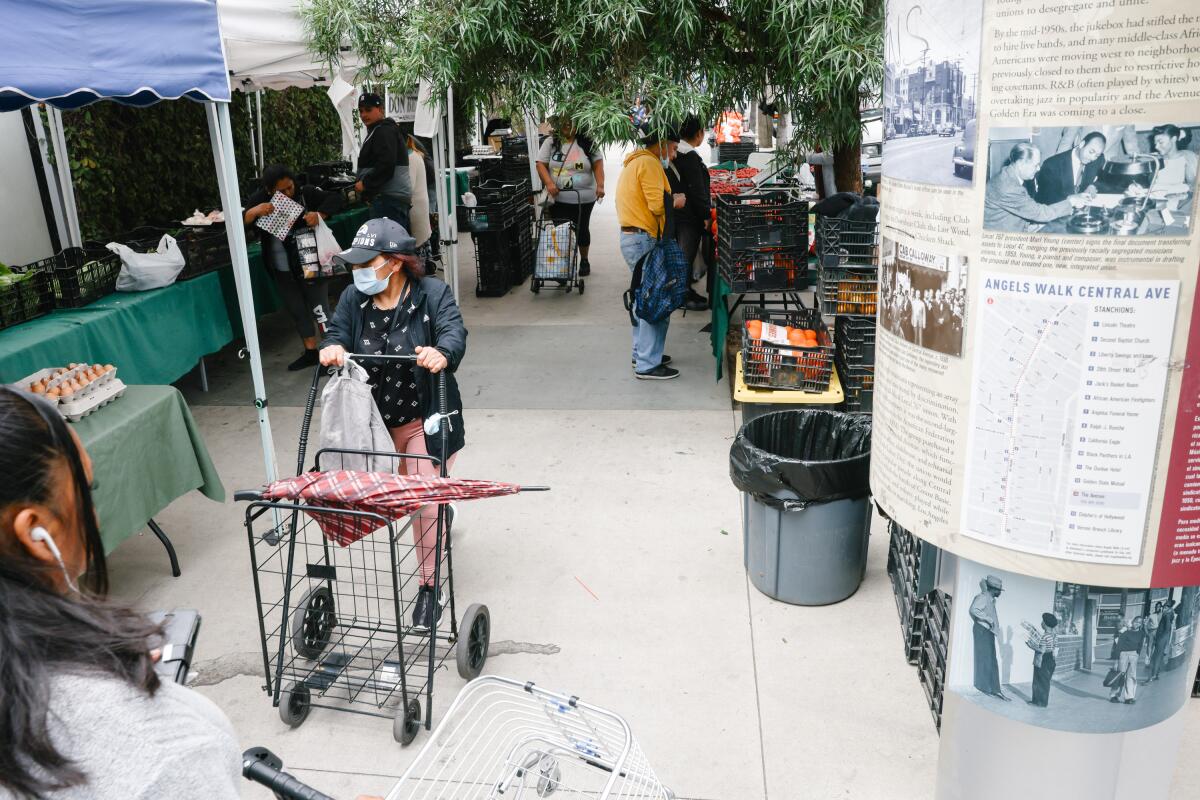
Mexican Americans were overwhelmingly the victims in the Zoot Suit riots. But the mobs went after Black men as well.
The NAACP field office logged dozens of incidents: Joseph Nelson, 16, got dragged out of a car at 5th and Main streets and had his pants cut. Louis Jackson, 23, a shipyard worker, had an eye gouged out after being jumped at 3rd Street and Santa Fe Avenue. Two Black teenagers wearing zoot suits had to seek refuge at the Pasadena police station from marauders.
The riots reached their climax the night of June 7, as an estimated 5,000 civilians swarmed into downtown Los Angeles. Servicemen barged into movie theaters and stripped off the zoot suits of anyone wearing them. At 12th Street and Central Avenue, rioters forced two teens to take off their offending clothes and burned the suits in front of them.
South L.A. was next.
Loren Miller, a former Eagle editor who wrote at the time for another Black-owned newspaper, the Los Angeles Sentinel, called Mayor Bowron and let him know any push south wouldn’t end well for the sailors.
“We were going to raise hell and see that anybody that came over in the Negro community looking around for any trouble was going to find plenty of trouble,” Miller said in an interview decades later. “If anybody came up to 12th and Central, somebody was going to get killed, and I didn’t think it was going to be Negroes.”
Hundreds of pachucos came from the Eastside to help their Black peers. They “loaned us their cars to use,” Rudy Leyvas told the Times in 1978. “[Servicemen] were surprised. It was the first time anybody was organized to fight back.”
The ensuing brawl saw police officers join in. But any advance south stopped for the night.
Two days later, rioters tried one final invasion of South L.A. when 150 sailors and Air Corps members hitched rides to Watts. Throughout the riots, Black and Mexican zooters had thrown rocks at Pacific Electric Red Cars heading to the neighborhood packed with servicemen looking for pachucos. After ignoring, if not condoning, the riots, military brass had finally intervened and declared Los Angeles off limits to military personnel. Thinking Watts was its own city, the service members marched through the streets with clubs, pipes and bottles singing military tunes while shouting: “Where are the zoot suiters?”
Before anything major happened, military police arrived and ordered the aspiring rioters back to their bases. Civilian police, meanwhile, arrested more than 20 Black and Mexican American teens for continuing to throw rocks at the Red Cars.
“There was an interracial aspect to the resistance from the very beginning,” Alvarez said. Black and Mexican American Angelenos “were going to concerts together. They were traversing pool halls and backyard parties together. They were in relationships. They were supposed to be invisible and silent, and they were seen and heard. ”
The public forgot this history, the professor argued, because the Chicano movement rehabilitated the pachuco “as an icon and figure of resistance against white supremacy” and thus ignored other victims. In the Black community, meanwhile, “the story there is Malcolm Little turning in his zoot for another suit and becoming Malcolm X.”
Alvarez understands why the two narratives emerged and continue. But he stressed that teaching the Zoot Suit Riots as a multicultural affair “reminds us about the interconnection between Mexican American history and African American history. Those of us who care about those fields understand that we can’t necessarily tell the story of one without the other.”
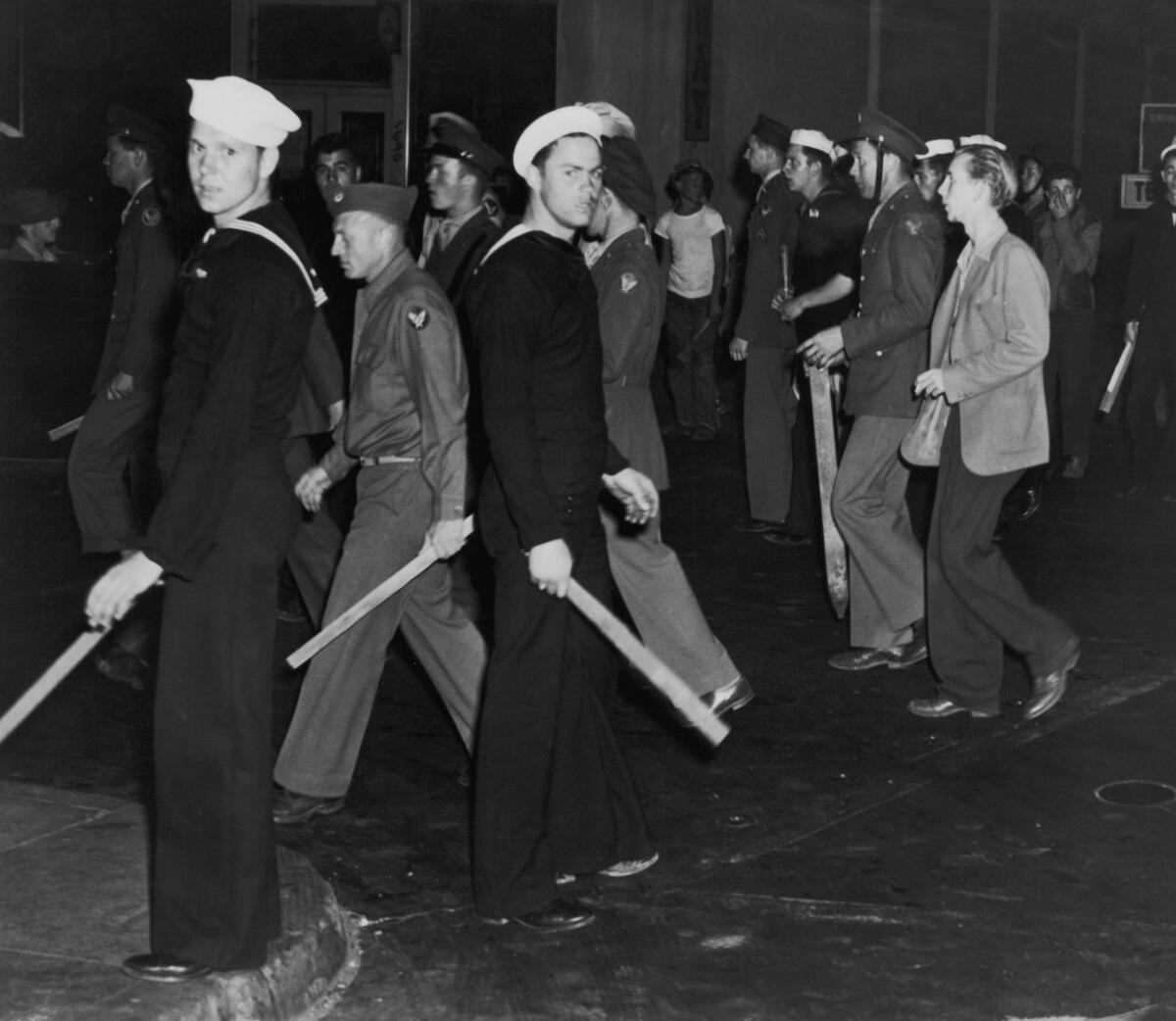
Outside the Central Avenue Constituent Services Center, there’s a display mounted on a street pole that touts the area’s history in English and Spanish. I asked L.A. Councilmember Curren Price, who met me the day I went to the farmers market, if the display mentioned the riots.
He read through it. Nothing. Nada.
“I knew Black folks were sucked into” the riots, he said. “And I knew that the reason why was because society wanted to attack a group of young men for how they dressed. Yesterday, it was zoot suits; today it’s long white T-shirts and hoodies.”
Price told me that memory of the riots is stronger among Mexican Americans because Black Angelenos weren’t the primary targets. The South L.A. politician nevertheless thinks about the riots every time he visits his headquarters at the service center, though.
The mural with Charlotta Bass and the injured pachucos stands right outside the doors to his offices.
It’s a “constant reminder of the challenges that Black and brown people faced in our community,” he said.
He knew about the People’s Victory Market, but not the Eagle ad urging the Black community to stand with Mexican Americans. He beamed when I explained it to him. “There’s a track record of good between Blacks and Latinos — yeah, there’s been fights, but the record shows that if we’re working together, we can be victorious.”
That how Corona, the farmers market manager, felt as well.
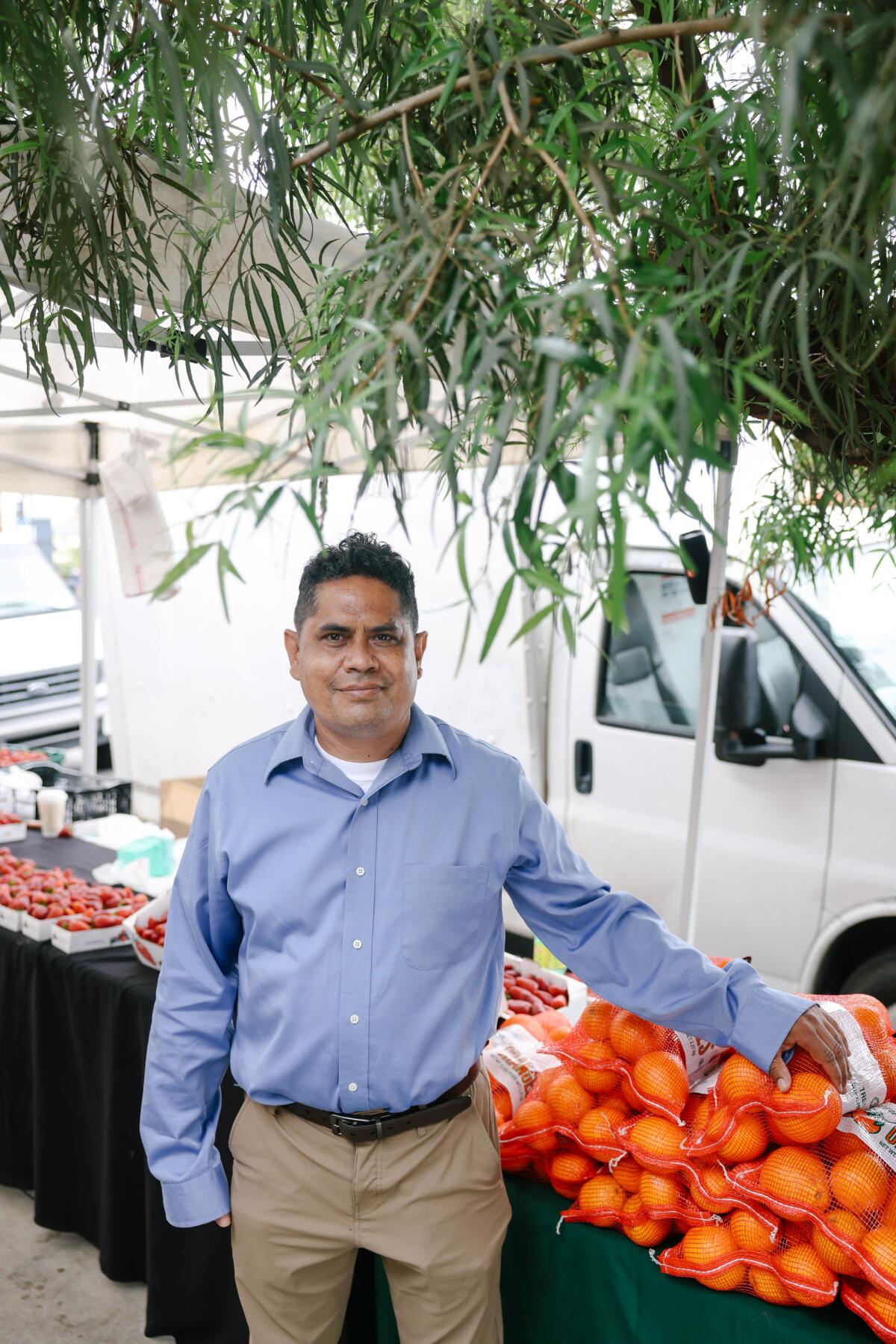
The Mexican immigrant was familiar with zoot suits through the films of the Mexican comedian Tin-Tan, who satirized pachuco culture in a series of films in the 1940s and 1950s. But Corona, a native of Mexico’s Jalisco state, had never heard of the riots until I told him. He researched them the night before we spoke.
“They [servicemen] used it as an excuse to beat up people who didn’t have voto y voz,” he said. No vote and no voice.
He took particular inspiration in the People’s Victory Market, which closed down in the early 1950s. “It was great that back then, people were advocating for food justice the way we are today.”
Traffic buzzed by. Vendors were beginning to break down their booths at the farmers market.
“If you want to see good things today,” Corona concluded, “sometimes you have to look to the past to learn how to do them.”
More to Read
Sign up for Essential California
The most important California stories and recommendations in your inbox every morning.
You may occasionally receive promotional content from the Los Angeles Times.











